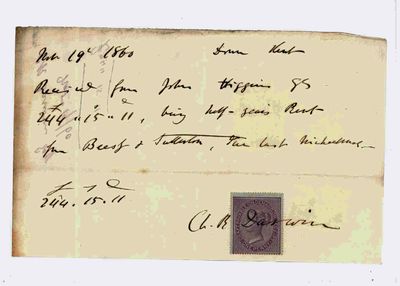
Charles Darwin
Charles Darwin ALS November 19, 1860
Down Kent England, November 19, 1860
- $4,500
Charles Darwin Autograph Letter Signed 1860
DARWIN, CHARLES. Autograph Letter Signed, "Ch. R. Darwin" over a one penny stamp, November 19, 1860, 1 p., Down Kent. Horizontal fold and toning. Docketed on verso.
Darwin writes to his land agent, John Higgins, regarding rent collected from Darwin's farm at Beesby, "Received from John Higgins Esq. / 244: 15: 11, being half year's rent ...
This item comes with a Certificate from John Reznikoff, a premier authenticator for both major 3rd party authentication services, PSA and JSA (James Spence Authentications), as well as numerous auction houses.
WE PROVIDE IN-HOUSE SHIPPING WORLDWIDE.
More from University Archives
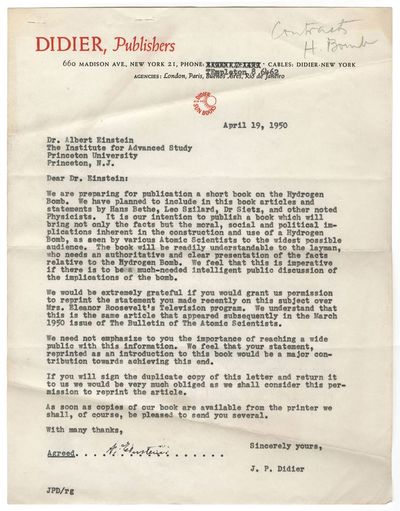
Albert Einstein TLS re: The Bomb
Albert Einstein Princeton NJ, April 19, 1950 Einstein and the Bomb: "the moral, social and political implications inherent in the construction and use of a Hydrogen Bomb" 1p TLS signed by physicist Albert Einstein (1879-1955) as "A. Einstein" at lower left. Signed in Princeton, New Jersey on or soon after April 19, 1950. On "Didier, Publishers / 660 Madison Ave., New York" letterhead. Accompanied by the original transmittal envelope with "The Institute for Advanced Study / School of Mathematics / Princeton, New Jersey" letterhead. The letter is lightly creased and folded, else near fine, 8.25" x 11.25". Company president J.D. Didier wrote Einstein expressing interest in reproducing a televised speech that the physicist had delivered against the use of the Hydrogen Bomb in a short book the firm was preparing on the same subject. On February 12, 1950, Einstein had appeared on Eleanor Roosevelt's television program, and warned that: "The armament race between the U.S.A. and the U.S.S.R., originally supposed to be a preventive measure, assumes hysterical character. On both sides, the means to mass destruction are perfected with feverish haste -- behind the respective walls of secrecy. The H-bomb appears on the public horizon as a probably attainable goal. If successful, radioactive poisoning of the atmosphere and hence annihilation of any life on earth has been brought within the range of technical possibilities ..." The letter from Didier Publishers was addressed to Einstein, signed by him in Princeton, and mailed back to the publishing firm the following day. "The H-Bomb" was published in September 1950, with Einstein's speech appearing as the book's introduction. Hans Bethe, Leo Szilard, and Dr. Sietz were also contributors. Albert Einstein was a German-Swiss born theoretical physicist internationally recognized as one of the greatest physicists of all time. He enunciated the general theory of Relativity, a law explaining the relationship between the speed of light and its consequence, and the equivalence of mass and energy (E=MC2). For his work in theoretical physics—largely for his 1905 paper on photons and photo-electricity—Einstein was awarded the Nobel Prize for Physics (announced in November 1922, retroactive for 1921). Working on a unified field theory, he then attempted to explain gravitation and electromagnetism within one set of laws. After Hitler's rise to power and the subsequent expulsion of Jewish scholars from Germany, Einstein joined the Institute for Advanced Study in Princeton, New Jersey (1933), which became the most celebrated research center in the world. In 1939, he signed a letter written to President Franklin Roosevelt warning him of the possibility of Germany developing a nuclear bomb. He urged the U.S. to begin uranium research, thus beginning the top secret "Manhattan Project." Later, at Princeton, he tried to develop a unified field theory and to refute the accepted interpretation of quantum physics, both unsuccessfully. Einstein received U.S. citizenship in 1940. This item comes with a Certificate from John Reznikoff, a premier authenticator for both major 3rd party authentication services, PSA and JSA (James Spence Authentications), as well as numerous auction houses. WE PROVIDE IN-HOUSE SHIPPING WORLDWIDE!- $14,000
- $14,000
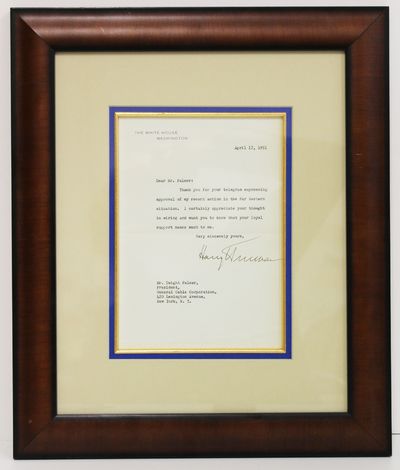
Harry Truman TLS Re: Firing Gen’l. Douglas MacArthur
Harry S. Truman Washington DC, April 17, 1951 Harry Truman TLS Re: Firing General Douglas MacArthur. Single page typed letter signed on White House stationary letterhead. Dated "April 17, 1951", and signed by President Harry Truman as "Harry Truman". Framed with visible area of the letter by sight 8.25" x 5.5". Framed to 13.5" x 16". Fine condition, not examined out of frame. Truman writes to Dwight Palmer of New York, thanking him for his "telegram expressing approval of my recent action in the Far Eastern situation" (alluding to dismissal of MacArthur). In one of the most controversial civilian-military events of the 20th century, on 11 April 1951 President Truman fired General Douglas MacArthur, then in command of the U.S. forces in Korea, and replaced him with General Matthew Ridgeway. In 1951, the scars of World War II across the world were still fresh. The fear of having to engage in another world war was very real. A mere two years after the end of WWII, the Cold War began. The United Nations, which was formed to provide a forum to prevent future wars, included the membership of the Soviet Union, the United States, the United Kingdom and 57 other countries. The US adopted a firm stance to contain the spread of communism, which was being aggressively promoted by the USSR. The Korean War began when the North Korean People's Army (NKPA) crossed the 28th parallel into South Korea. Adhering to its policy of containment, the United States could not ignore the threat of communism in Asia, but neither the president nor the public wanted a long, drawn out war. President Truman hand selected General Douglas MacArthur to lead the U.S. troops in South Korea. MacArthur arrived at his post a World War II hero, having successfully led multiple troops through the war. Following his victories in WWII he had become the Supreme Commander for the Allied Powers in Japan. MacArthur was revered and highly praised in the United States. The general assured the president that the Korean War would be short-lived and that the American troops would be home by Christmas. MacArthur was initially successful in driving back the North Korean forces over the 38th parallel. He made a controversial move, however, when he continued to push the North Koreans further north and suggested bombing cities in China that were thought to be aiding the North Korean troops. In pushing for a larger conflict, MacArthur downplayed the risk of inciting a massive war in Asia. President Truman's main concern was saving as many lives as possible, even if that meant signing a ceasefire along the 38th parallel. General MacArthur did not think a ceasefire was an appropriate solution. The two men clashed. For Truman, the war represented an opportunity to stop the spread of communism into South Korea. For MacArthur, the war was an opportunity to liberate the North from communist control, and aggressive action was required. MacArthur thwarted Truman's attempt to negotiate a ceasefire when the general ordered his troops to invade North Korea and push the NKPA up past the 38th parallel. This was not the first time the general had ignored direct orders from his Commander in Chief. On April 11, 1951, President Truman officially relieved Douglas MacArthur of his command. Word of his firing spread quickly, and the American public found the news upsetting. Truman felt that his decision was just, because MacArthur had overstepped his authority, defied direct orders from his superior and interfered with Truman's hope of ending the Korean War quickly. Accompanied by a certificate and receipt from EAC Gallery, New York reporting this item purchased on Sothebys.com, 2002. WE PROVIDE IN-HOUSE SHIPPING WORLDWIDE!- $2,400
- $2,400
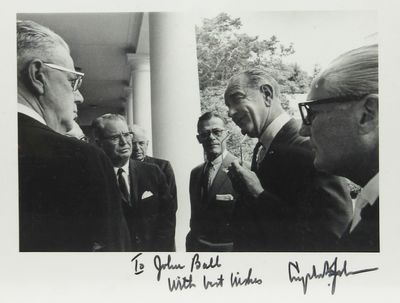
Lyndon B. Johnson Signed and Inscribed Photo
Lyndon B. Johnson Lyndon B. Johnson Signed & Inscribed Photo A black and white vintage photographic print of President Lyndon B. Johnson (1908-1973) inscribed and signed by him as "To John Ball / With best wishes / Lyndon B. Johnson" along the bottom margin. Slight feathering to the words "best" and "wishes", otherwise nicely bold and dark. Currently shrink wrapped on a piece of cardboard. Not examined under shrink wrap. The photographic image measures 11.5" x 7.75" while the stock card measures 14" x 11" overall. The picture depicts President Johnson conversing with a group of men standing under one of the White House colonnades. Johnson's dedicatee was presumably John W. Ball, a judge from the Fifth Circuit Court of Appeals, whose jurisdiction included Johnson's home state of Texas. This item comes with a Certificate from John Reznikoff, a premier authenticator for both major 3rd party authentication services, PSA and JSA (James Spence Authentications), as well as numerous auction houses. WE PROVIDE IN-HOUSE SHIPPING WORLDWIDE!- $400
- $400
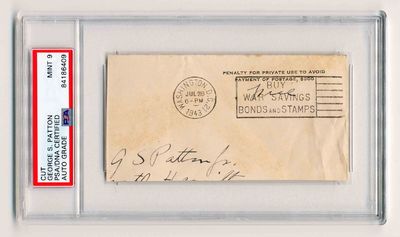
George Patton WWII Signature and Free Frank – PSA
George S. Patton (Washington DC), July 28 1943 George Patton, Jr. FF, PSA/DNA Encapsulated & Graded Mint 9! Part of a free franked envelope signed by future 4-star U.S. Army General George Patton, Jr. (1885-1945) as "G S Patton Jr." at lower left. Patton also wrote "free" in the postage section at upper right. PSA graded Mint 9. Postmarked in Washington, DC on July 28, 1943. Light overall toning, isolated foxing, and expected wrinkles, else near fine. The envelope fragment measures 4.75" x 2.5" while the slab measures 7.125" x 4.125". Patton signed this envelope just days after commanding Seventh United States Army units in Operation Husky, the invasion of Sicily, in mid to late July 1943. Patton's Americans facilitated the landing of Bernard Law Montgomery's British Eighth Army, and scourged the island's Axis forces. George Patton, Jr. was a career military officer whose 36 years of military service spanned three military conflicts including both world wars. Patton sortied against partisans of Pancho Villa in Mexico in 1915-1916, and he was later dispatched to the Western Front as a personal aide to General John "Black Jack" Pershing. It was during World War II, however, that Patton made his most indelible mark. "Old Blood and Guts" served as an army commander leading Allied expeditions in North Africa, Sicily, Normandy, eastern France, the Benelux Countries, and Germany. Patton died of complications following a car accident in Luxembourg in December 1945. This item comes with a Certificate from John Reznikoff, a premier authenticator for both major 3rd party authentication services, PSA and JSA (James Spence Authentications), as well as numerous auction houses. WE PROVIDE IN-HOUSE SHIPPING WORLDWIDE!- $700
- $700
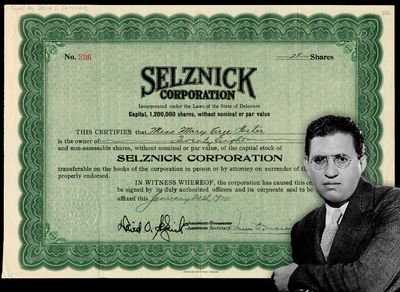
David O. Selznick Signed Selznick Corporation Stock Certificate
David O. Selznick David O. Selznick Signed Selznick Corporation Stock Certificate 1p "Selznick Corporation" stock certificate signed by David O. Selznick (1902-1965), the son of company founder Lewis J. Selznick (1869/70-1933), in his role as company secretary as "David O. Selznick" at lower left. Also signed by company vice-president Sam E. Morris. Signed on January 20, 1922. The stock certificate was partly printed and partly handwritten on watermarked cream paper. It granted 28 shares to "Miss Mary Cree Porter". Embossed seal at lower left. Stock transfer section blank verso. Expected light paper folds and a few scattered pencil inscriptions from a former collector, entirely reversible. Else near fine. 11" x 7.625". Selznick Corporation, founded by early motion picture industry producer Lewis J. Selznick, was incorporated on May 1, 1920. The 1,200,000 share company produced films on three studio lots in Fort Lee, New Jersey, and also distributed films to 7,000 American theaters nationwide. Though initial earnings reports exceeded $1 million in net income, the company encountered serious financial reversals and finally folded in 1923. Certificate signee David O. Selznick was the 21-year-old youngest son of Lewis J. Selznick, and brother of talent agent Myron Selznick. David O. Selznick would go on to become one of Hollywood's most famous movie producers, and established his own production company, Selznick International Pictures, in the mid-1930s. David O. Selznick produced Academy Award-winning films such as A Star is Born (1937), Gone with the Wind (1939), and Rebecca (1940). This item comes with a Certificate from John Reznikoff, a premier authenticator for both major 3rd party authentication services, PSA and JSA (James Spence Authentications), as well as numerous auction houses. WE PROVIDE IN-HOUSE SHIPPING WORLDWIDE!- $350
- $350
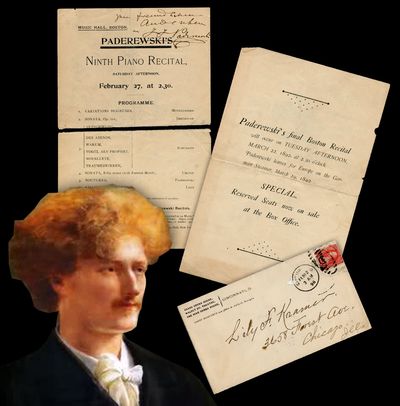
Ignace Jan Paderewski Signed Concert Program
Ignace Jan Paderewski Ignace Jan Paderewski Signed Concert Program, Ca. 1890s Three pieces of ephemera relating to Polish concert pianist Ignace Jan Paderewski (1860-1941), including a program page signed by him and inscribed by him in German. The materials date from Paderewski's American concert tours of the 1890s, when the artist was sponsored by the famous piano manufacturing company Steinway & Sons. The lot includes: 1. Program page from Boston's Music Hall, advertising "Paderewski's Ninth Piano Recital", on February 27, [1892]. Signed by Paderewski as "I J Paderewski" and with six words inscribed by him in German in the upper right hand corner recto. A full page advertisement of Steinway & Sons, containing an endorsement by the British royal family, is found verso. With expected folds. Split along the horizontal fold at center. A few chipped edges, else very good. 5.75" x 9". The pianist was slated to play selections from Liszt, Chopin, Beethoven, Schumann, and Mendelssohn in the afternoon concert, as well as a Nocturne composed by himself. "The 'Steinway' Piano used at all the Paderewski Recitals" appears in bold at bottom recto. 2. Program page advertising "Paderewski's final Boston Recital [which] will occur on TUESDAY AFTERNOON, MARCH 22, 1892, at 2.30 o'clock." Another full page advertisement of Steinway & Sons is found verso, including an illustration of a grand piano. Expected folds, and a minor closed tear at center. Else very good to near fine. 5.75" x 9". 3. An envelope addressed in Paderewski's hand to "Lily F. Kramer / 3658 Forest Ave / Chicago, / Ill." postmarked from Cincinnati, Ohio on February 12, 1896. The pre-printed return address lists three of Cincinnati's concert venues, including the Grand Opera House. Ignace Jan Paderewski was one of the most popular concert pianists of the late-nineteenth and early-twentieth centuries. He was the darling of audiences, who loved his unruly red hair and his intensely physical, often violent manner of playing. (Paderewski was injured during a concert in Rochester, New York, leading to the permanent loss of use of his right ring finger, and his overworked and infected fingers often bled on the keyboard.) He played in an unorthodox style in part because he learned piano late in life. Paderewski began undertaking worldwide concert playing tours after graduating from the Warsaw Conservatory and training in Vienna. Paderewski performed some 107 concerts during the 117 days of his 1891-1892 American tour, of which these winter 1892 concerts were some, under sponsorship by Steinway. This item comes with a Certificate from John Reznikoff, a premier authenticator for both major 3rd party authentication services, PSA and JSA (James Spence Authentications), as well as numerous auction houses. WE PROVIDE IN-HOUSE SHIPPING WORLDWIDE!- $300
- $300
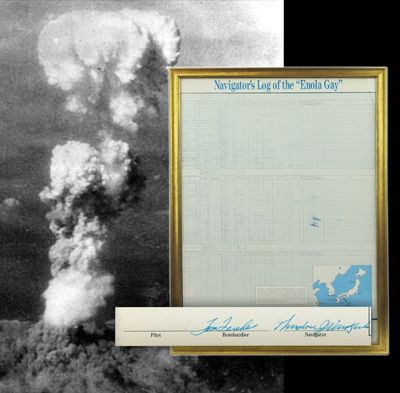
Enola Gay Souvenir Navigator’s Log Signed by 3 Crew Members
Enola Gay Enola Gay Souvenir Navigator's Log Signed by 3 Crew Members: Tibbets, Ferebee, & Van Kirk A color poster reproducing the August 6, 1945 navigation log of the B-29 bomber Enola Gay, signed by three of its crew members: pilot Colonel Paul W. Tibbets (1915-2007) as "Paul W. Tibbets" at left; bombardier Major Tom Ferebee (1918-2000) as "Tom Ferebee" at center; and navigator Captain Theodore J. "Dutch" Van Kirk (1921-2014) as "Theodore J Van Kirk" at right. Supplemented by a schematic showing Enola Gay's route inset at lower right, and Van Kirk's comments about local time, geography, and navigational calculations inset at lower center. Tibbet's signature is faded, though still visible. Else near fine. Framed behind glass, not examined out of frame. Overall size measures 19.75" x 25.75" x .75". Ex-Kenneth Rendell. Enola Gay's 12-person crew left their home base at Tinian, in the Northern Mariana Islands, at 2:45 am Tinian time on August 6, 1945. Their objective was to drop an atomic bomb, called Little Boy, on the city of Hiroshima, Japan, located some 2,500 km to the northwest. The reproduction navigation log documents Van Kirk's notes as they passed landmarks, such as Iwo Jima and Mishima, Japan. The plane gradually gained in altitude until it passed over its target of Hiroshima. At 9:15 Tinian time, at an altitude of 31,060 feet and an air speed of 200 mph, Van Kirk listed "Bomb Away" in the Position column. Enola Gay gradually descended and turned south, arriving in Tinian at 2:58 pm Tinian time. Little Boy had enough force to wipe out 90 percent of the city and immediately killed 80,000 people; tens of thousands more would later die of radiation exposure. The Japanese surrendered nine days later. This item comes with a Certificate from John Reznikoff, a premier authenticator for both major 3rd party authentication services, PSA and JSA (James Spence Authentications), as well as numerous auction houses. WE PROVIDE IN-HOUSE SHIPPING WORLDWIDE!- $900
- $900
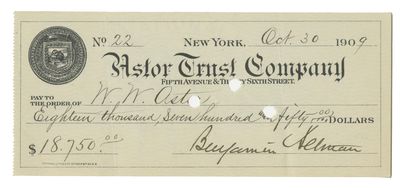
Benjamin Altman Signed Check to W.W. Astor, Worth $500,000 in Today’s Money
B. Altman of Department Store Fame Benjamin Altman Signed Check to W.W. Astor, Worth $500,000 in Today's Money Benjamin Altman Signed Check, 6.5" x 2.75", drawn on the bank of "Astor Trust Company". Dated "October 30, 1909" and made payable to "W.W. Astor" for "Eighteen thousand, seven hundred and fifty", written additionally as "18,750". Signed by Benjamin Altman in full signature "Benjamin Altman". The value of the check in today's money is about $500,000.00. Cancellation holes not affecting the signature. Fine condition. Benjamin Altman, American merchant, art collector, and philanthropist, established one of the world's great department stores, B. Altman & Co. Altman had little formal schooling, but at the age of 25 he opened his first dry-goods store in Manhattan and in 1906 moved it to the uptown section, pioneering the movement of business there. With additions in 1913–14, the store occupied the entire block bounded by Madison and Fifth avenues and 34th and 35th streets. The Astor Trust Company was a financial institution at 5th Avenue and 36th Street headed by John Jacob Astor IV, William Waldorf Astor's cousin. Benjamin Altman was a director and a stockholder in the Astor Trust Company. After Altman acquired property owned by W.W. Astor in 1910 on a long lease, he owned outright more than half of the block bordered by Fifth and Madison Avenues, between 34th and 35th Streets. What he did not own was held on long leases from Astor. This check most probably was payment for property leased by Altman from Astor. In today's terms, this check would be valued close to $500,000.00. The department-store chain Altman founded eventually numbered seven stores in New York and other cities. The chain closed in 1989. This item comes with a Certificate from John Reznikoff, a premier authenticator for both major 3rd party authentication services, PSA and JSA (James Spence Authentications), as well as numerous auction houses. WE PROVIDE IN-HOUSE SHIPPING WORLDWIDE!- $300
- $300
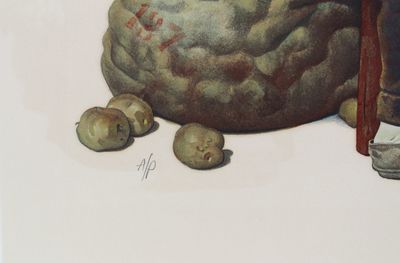
Norman Rockwell Signed Artist Proof
Norman Rockwell Norman Rockwell Signed Artist Proof for the Nov. 1931 Cover Illustration for The Saturday Evening Post "Trumpeter" Stunning fine condition, November 7, 1931 Cover illustration for The Saturday Evening Post, the "Trumpeter" (Sour note). Signed by Norman Rockwell in graphite in the lower right corner "Norman Rockwell". The initials of A/P are in the left lower corner (Artist's Proof). A large and vibrant piece on Arches paper with a deckled edge, 21" x 26.5". Originally created for the November 7, 1931 edition of the Saturday Evening Post, Trumpeter was hand proofed and printed by Circle Gallery. This full color lithograph measures 27 by 21 inches and the edition consists of 320 impressions. A set of 200 were numbered. Another set of 35 were A/P's numbered with Roman numerals. A set of 60 were unnumbered; another set of 25 were unnumbered and printed on Japon paper. All of the prints made were signed in pencil by Norman Rockwell. Norman Rockwell published over 300 original covers for the Saturday Evening Post from 1916 to 1963. While at first glance this cover seems to be a period study of a nineteenth-century bandsman, it is in fact the depiction of a twentieth-century grocer rehearsing for his part in the local marching band. If the dog's expression is any indication of how skilled this musician is, then the trumpeter's abilities are strictly those of an amateur. A similar artist proof is available at the Norman Rockwell museum store (one of the numbered artist proofs), which is listed for $4,000. An image of the final cover drawing is shown in the listing for review only and will NOT accompany the piece for sale. WE PROVIDE IN-HOUSE SHIPPING WORLDWIDE!- $1,500
- $1,500
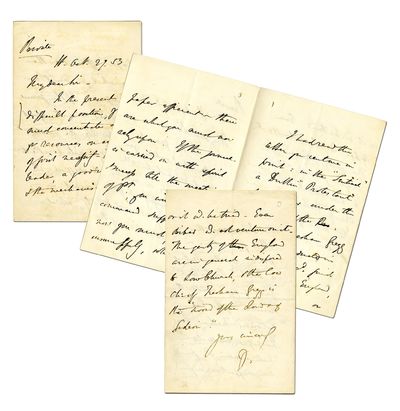
Benjamin Disraeli ALS Offering Business Advice to Newspaper’s Editor
Benjamin Disraeli Disraeli Offers Business Advice to His Newspaper's Editor "If the journal is carried on with spirit & success till the meeting of Pt, you will be able to command support...." This interesting letter by Benjamin Disraeli, a key leader in the House of Commons, urges the editor of The Press newspaper that Disraeli had established to continue editing carefully until the meeting of Parliament, when they can raise more support for it from fellow Conservatives. BENJAMIN DISRAELI, Autograph Letter Initialed, to Samuel Lucas, October 29, 1853. 4 pp., 4.5" x 7.25". Expected folds; hole in top left corner, not affecting text. Complete Transcript Private [W?] Oct. 29, 53 My dear Sir, In the present difficult position, you must concentrate all yr resources on articles of joint necessity. A good leader, a good inner page, & the mechanism of the paper efficient—these are what you must now rely upon. If the journal is carried on with spirit & success till the meeting of Pt, you will be able to command support, wh: now you must, & unsuccessfully, solicit. I had read the letter you sent me in print: in the "Sentinel" a Dublin "Protestant Jack" paper under the direction of the notorious Tresham Gregg No paper conducted in such a vein cd find any support in England, or it wd be tried. Even Bibles wd not venture on it. The gentry of England are in general indisposed to Low Church, & the low chief Tresham Gregg is the "sword of the Lord & of Gideon." Yrs sincerely D. Historical Background: Early in 1853, Disraeli worked to establish a weekly newspaper that would raise the level of Conservative journalism and propagate his own Tory Democratic ideas. He initially considered Daniel O. Maddyn, who had served on the Morning Chronicle, for editor, but settled on Samuel Lucas, who had for many years been a well-known writer for The Times. In March 1853, Lucas began collecting his staff under Disraeli's inspiration. The first issue of The Press appeared on May 7, 1853. It was published every Saturday morning, and was both a newspaper and a review. It included a short report of Parliamentary proceedings, common news items, leading articles on home and foreign politics, and critical essays on literature and the arts. The Rev. Tresham Dames Gregg (1800-1881) was born in Ireland and received his BA degree in 1826, his MA degree in 1830, and his Doctorate of Divinity in 1853. From 1837, he served as chaplain of Swift's Alley Free Church in Dublin. He was a prominent and controversial figure in both religious and political matters. As a militant Protestant clergyman, he spent much of his career campaigning against Catholicism. In May 1854, Lucas resigned as editor of The Press, apparently at Disraeli's urging. Benjamin Disraeli (1804-1881) was born in London into a Sephardic Jewish Italian mercantile family. His father had his four children baptized into the Church of England in 1817, which opened the possibility of a political career. Disraeli was brought up as an Anglican, "the blank page between the Old Testament and the New," as he described himself. He first stood for election in 1832 as a Radical, but lost. In 1835, after running as a Tory and again losing, he began writing for the Tory Party. In 1837, he won a seat in the House of Commons, his campaign funded in part by his writing of novels. He married widow Mary Anne Lewis (1792-1872) in 1839, who was wealthy and a dozen years his senior. Disraeli hoped to forge a paternalistic alliance between Tories and Radicals, and while he developed a personal relationship with radical John Bright, he was unsuccessful in establishing an alliance. During the repeal of the Corn Laws in 1846, Disraeli led the protectionists who battled repeal. In the late 1840s, Disraeli purchased Hughenden Manor, in Buckinghamshire. Disraeli served as Chancellor of the Exchequer and Leader of the House of Commons under the Earl of Derby as Prime Minister in 1852, from 1858 to 1859, and again from 1866 to 1868. He served as Prime Minister in 1868 and again from 1874 to 1880, succeeded each time by Liberal Party leader William Gladstone. Disraeli maintained a close relationship with Queen Victoria, and in 1876, she appointed him as Earl of Beaconsfield. He published his last completed novel shortly before he died at the age of 76. Samuel Lucas (1811-1865) was born into a Quaker family. In 1839, he married Margaret Bright (1818-1890), a younger sister of reformer John Bright (1811-1889). From 1845 to 1850, Lucas lived in Manchester, where he had an interest in a cotton mill and supported public schools. He and his wife were abolitionists and reformers who fought for the industrial middle class by participating in the Anti-Corn Law League, founded in 1838 by Richard Cobden and John Bright. They represented what Benjamin Disraeli called the "Manchester School" of economics that advocated a free market with only minimal government regulation. Back in London, Lucas served for one year as the inaugural editor of The Press (1853-1858), a weekly newspaper begun by Disraeli. Six years later, Lucas became the editor of the Morning Star (1856-1869), an abolitionist newspaper begun by Cobden and Bright in 1856 that was the only national British newspaper to support the Union side in the American Civil War. In 1859, Lucas also became the editor of the newly established Once A Week literary magazine (1859-1880). This item comes with a Certificate from John Reznikoff, a premier authenticator for both major 3rd party authentication services, PSA and JSA (James Spence Authentications), as well as numerous auction houses. WE PROVIDE IN-HOUSE SHIPPING WORLDWIDE.- $400
- $400
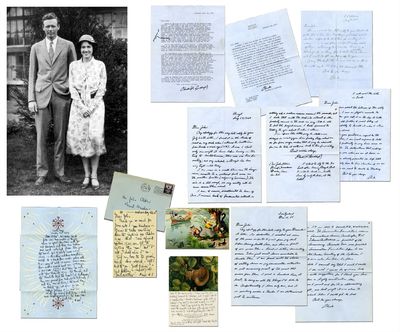
Charles and Anne Lindbergh Archive 1950-1980
Charles & Anne Lindbergh Charles Lindbergh and Anne Lindbergh Share Life and Loss with Connecticut Neighbor and Author CHARLES A. LINDBERGH, Archive of thirty-four letters, notes, and postcards, most written by Charles A. Lindbergh and Anne Morrow Lindbergh, to John Oldrin, 1951-1980, from a variety of locations. Of the letters, six are written or signed by Charles Lindbergh, twenty by Anne Lindbergh, and a few more by Lindbergh children; most with envelopes; includes two poems, one each by Anne Morrow Lindbergh and Reeve Lindbergh. Approximately 50 pp. Some tears on envelopes from opening, but overall very good. This charming collection of letters includes Charles Lindbergh's reflections on conservation and fame and Anne Lindbergh's love of writing and nature, as they write to their friend and Darien, Connecticut, neighbor John Oldrin over three decades. Oldrin wrote a series of successful children's books regarding animals and shared a love of poetry and children with Anne Lindbergh and a love of nature with all the Lindbergh family. Highlights and Excerpts: Charles A. Lindbergh letters: August 24, 1968, Brazil, 2 pp. "Since I spent only one night at home before leaving on this trip to South America, there was no time for writing; and my schedule in Brazil has been very tight until today. I am now in a small plane over the Amazon river, enroute to a national park area on the northern frontier (adjoining Surinam). The air is a bit rough, so my writing will be even worse than usual." "I am, of course, disappointed to learn of Mrs. [Ioccoci's?] lack of fundamental interest in setting up a nature reserve around the swamp; but I hope that with the definite interest of other property owners in the area we may still be able to put the project across. I look forward to talking to you about it when I return. I'm afraid this letter may be still more delayed in reaching you. Our fueling stops ahead are so far from major centers that it may be advisable for me to take it with me back to Rio for mailing." [P.S.] "I expect to fly to the Far East after leaving Brazil. But I will be back in Scotts Cove by early October at the latest." May 18, 1969, Philippines, 1 p. "This is a much-too-late reply to your April 10th note, but I have been travelling a great deal and it has been difficult to find time for writing. I am now in a small plane over the China-Sea coast of Luzon, returning to Manila. The air is a bit rough for writing; but I won't have another chance and I want to get something off to you." December 15, 1969, Switzerland, 3 pp. "In desperation, I scooped up some of the more important mail from my desk before leaving Scotts Cove, and have in front of me more than a hundred letters demanding an answer. There just weren't hours available to handle them. I am faced with the choice of cutting down on my conservation activities or not answering most of the mail that arises from them. I need a hundred lives, at least, to carry on all the things I'd like to do. Unfortunately I have only one, and it is working under a tempo I am determined not to continue." "Personally, I am not a man for anniversaries, ceremonies, and celebrations. There are always ways in which I would rather spend my time. However, I respect fully the viewpoints of people who do care for these things, and I wish you every success in the anniversary you are planning for. I think your idea of using it to emphasize the essential need of conservation and preservation is excellent." Oldrin served as co-chairman of the 150th anniversary celebration of the town of Darien, Connecticut, incorporated in 1820. n.d. [ca. 1969], "I will mail this letter in Europe" [Switzerland], 1 p.: "Sorry again about the lateness of this reply to your letter. I was on flight 2 enroute to Hong Kong when you left it in the box at Scotts Cove. It's the old problem of mail piling up beyond my ability to handle it when I return from these trips abroad. Replying to your questions in regard to the Darien celebration, I am most anxious to hold down personal publicity in my home area so far as possible. The distractions that impinge on home and on me when we are at home in Connecticut have already mounted so high that we will probably have to live elsewhere if we are to find the time we want to devote to thinking and writing." The Lindberghs purchased land on Maui, Hawaii, in 1971 and built a vacation home there. Over the next several years, they spent more and more time there. Charles Lindbergh died there in 1974. February 28, 1972, Hana, Maui, Hawaii, 1 p., Typed Letter Signed "As usual, I have been abroad and travelling almost constantly, with stops of only a few rushed days at a time in Connecticut and the city of New York. Mail has stacked up in hopelessly high piles. I have taken a few selected letters with me to Hawaii, and am now trying to answer them in addition to working on long-neglected manuscripts." "I am embarrassed, as I know I have written on a number of occasions before, to find myself answering a letter from you, months late -- Your November 30th letter enclosing the map related to wetlands restrictions, and explaining the effect of the restrictions on our property and the swamp. Very many thanks for both the map and the explanation. As you know, the more wetlands and conservation-oriented restrictions the better as far as Anne and I are concerned." October 10, 1972, Vermont, 1 p., Typed Letter Signed "I have reluctantly been forced to the conclusion that to carry on the activities and interests that mean most to me, I will be forced to move my permanent residence away from pressures of the New York area. I say reluctantly because our home on the Cove, where we have now lived for twenty six years, has come to mean a great deal to Anne and to me." "I have devoted so much of my time and money to conservation activities, which I feel are of such fundamental importance to human welfare – even to human existance – that I do not feel able to take part in other activities such as the library project." "Since time does not permit my taking part in the activities of the Connecticut Conservation Association, much as I try to assist conservation activities wherever possible, I will have to decline to become an honorary chairman – with emphasis on my deep appreciation of the offer." Anne S. Murrow Lindbergh letters: April 9, 1951, Note in Card "It is rare that anything in life is just perfect. But the budding magnolia branch in this vase was. It came in a time "In darkest February" (Far worse than darkest Africa!) when the trees were bare – and I could not even smell the blossoms! I return late but with gratitude for that February moment – your vase!" February 5, 1951, Note in Card "I know this isn't enough and I don't know how to thank you for letting Scott, Anne, Miss Knobel & I be children for a whole afternoon we wont any of us forget it. I send you a poem I wrote once on the importance of remaining a child! you don't need to be reminded of it!" May 1, 1952, Scotts Cove, Connecticut, Autograph Letter Signed, 3 pp. "I have just learned – this beautiful Spring morning – of Mrs. Oldrin's death. I know – from my sisters long forewarned death – that no matter how much one may be prepared beforehand and how much one may with one's rational mind feel and know & even be grateful for the release from suffering for the person who has gone – even so – the tearing away of a life one has shared is an amputation – a tearing of oneself in half – almost physical – so it is hard to walk & function alone in new patterns. I want to stretch out my hand to you, though I know of course that you are strong and will be able to meet and carry this as you have so much else – so unbelievably much." Oldrin's first wife, Edna Young Brenchley Oldrin (1881-1952), died on April 29. February 18, 1953, Darrien, Connecticut, Postcard in Envelope "Thank you so much for your note & your kindness in offering to take something down to Captiva for Charles or me. Alas, I am afraid neither of us can get to Captiva this year. Isn't it sad. I shall miss it so. Give my love to its pearly beach, dove-colored & soft. And to you, good fishing & good shelling & - most of all – good writing!" Both the Lindberghs and Oldrins vacationed on Captiva Island, off Fort Myers, Florida. March 28, 1954, "Little House," Postcard in Envelope "I liked the King Conch very much. (Except for the title which does not suggest its imaginative & yet real-life beauty) Why not do a book of Captiva sketches – shells – birds – etc? Perhaps you already have enough? I am working myself (Between weddings & ski-trips!) on a book that grew out of Captiva, but it is so slow & so hard to find time to write." Lindbergh published Gift from the Sea in 1955. March 1, ca. 1952-1955, Note in Card "your own story of 'Eight Rings on His Tail.' I am sorry to have kept it so long. I think it is excellent. Perhaps even better than your first. At least it gets going to a better start. Seems easier, more relaxed, than Dasher to begin with (First Drafts, I mean). You have a practiced hand now and must go on and on – I hope! My only question was if the episode on the island is really necessary. The book seems complete without it and it is such a dramatic and out-of-the-way incident that it doesn't quite seem in tune with The Meadow." May 3, 1956, Scotts Cove, Connecticut, Note in Card "Thank you for The Happy One which I have read with pleasure & absorption. I watched Scott read it with his usual deep sense of responsibility – and pride that you had asked him! He confided to me that he felt it was your best book. I asked him to elaborate – after I had read it. He said: 'It's more realistic – and you really know how chipmunks live and it has exciting things too – it held my interest.'" "I said, 'I think he has gone deeper into the animal world in this book.' What I meant by this is that you write more & more not as an adult human being trying to impersonate an animal – nor do you make children out of the animals (you do not patronize either animals or children – as many nature writers do.) You do not write down to them or of them. No, you are the chipmunk – and we go with her into her dark forsythia-rooted cosy world. Congratulations!" Oldrin published Chipmunk Terrace in 1958. August 29, 1958, Scotts Cove, Connecticut, Postcard in Envelope "Thank you for your acute perception of Scott – and for putting it on paper for me. You are right. Scott is coming into his own. 'His own,' was something you have always perceived, fed, and strengthened through the years. So you can best perceive its maturing – and feel a creative pride in it, too. You have given to all the children, but Scott needed what you had to give most – and was most blessed by it -as I have been, too, watching." January 11, 1959, Scotts Cove, Connecticut, Note in Card "All of us at Scott's Cove are very grateful for the beautiful Heritage book of the American Revolution that came to us for Christmas from Round Meadows. Scott – as you may know – feels that the American Revolution is his special period (chiefly through Kenneth Roberts). At one point this Fall he considered writing a poem about it. I countered, a little timidly that he might do better writing about 'something he knew about.' – a cold sail – or a trip West? He said he was tired of writing of things he knew about! Besides, he did know something about it! Now, he will know more. It is a fascinating book." The editors of American Heritage magazine published The American Heritage Book of the Revolution in 1958. Kenneth Roberts (1885-1957) wrote historical novels, and published three novels—Arundel (1929), Rabble in Arms (1933), and Oliver Wiswell (1940)—and an essay, The Battle of Cowpens (1958), on the American Revolutionary War. August 22, 1960, Les Paccots, Switzerland, Postcard "I am writing you from a steep meadow to a round one. On my meadow these flowers grow. I am sad to have them cut (by great scythes) as you were long ago on your tractor with Scott. I never hear a story of my children – like the one you wrote me of Scott – without rejoicing that you have Lucy and will have another child. You and Virginia deserve such happiness & not only deserve it but will make such wonderful children & be the most wonderful parents any children ever had. The world seems very right when one thinks of your family. I was touched that you should write me the news." June 28, 1974, Tellina, Darrien, Connecticut, Note in Card with Envelope "Charles is still in the hospital – much better but has occasional fever and they want to get it stabilized before he comes home.... I have been terribly busy – working all day at my manuscript – correcting & editing & notes – except when I go to see Charles at the Hospital." Charles Lindbergh died two months later in Hawaii. October 30, 1980, "Tellina," Darrien, Connecticut, Note in Card "Every time I walk into your meadows I feel grateful to you and Ginnie for all you have given to the community. I have recently been walking around the meadows with a cane (due to a malfunction – Meniere's Syndrome – of the center of balance in my ears!) Even with a cane it is still beautiful. But I am afraid my dog 'Berwick' chases the squirrels (He never gets one but it gives him exercise!)" Also includes a wedding announcement for Anne Spencer Lindbergh, December 23, 1963, in both English and French. Reeve Lindbergh to John Oldrin, ca. 1961, Switzerland, Autograph Letter Signed, 2 pp. "If I knew how to write welcome letters to people like John Wood Oldrin, I would have written him long ago, but I've tried, and I can't. So I wish you'd let him know I made an effort, and I want to say welcome, and see if he'll let me get away with that. I agree, it's terrible manners, but I did try. I wish I were home to meet him, but fairly soon I will be." "Here in Switzerland Spring is really coming, and it's very sad for us skiiers, who have to start packing away the skiis and talking about something else.... Water skiing?.... The skiing has been wonderful this year. Beautiful deep snow, long runs, wonderful weather. But I think there was more snow in New York this winter than there will ever be in the Swiss Alps! Last Wednesday afternoon (the school skiis all afternoon on Wednesday) I got an unbelievable sunburn which kept me in the house for four days. It was worth it though! In Switzerland you come to practically breathe skiing. Noone talks of anything else. Maybe I can interest Round Meadows' future 'Uncle John Jr.'? He'd probably be wonderful on skiis!" Charles A. Lindbergh (1902-1974) was born in Detroit, Michigan, and grew up in Minnesota and Washington, D.C., the son of a Swedish immigrant and later Congressman. He studied at the University of Wisconsin but dropped out early in 1922 to begin flight training in Lincoln, Nebraska. He flew solo for the first time in Americus, Georgia, where he had gone to purchase a World War I surplus biplane. After barnstorming, Lindbergh took a year of military flight training with the United States Army Air Service in San Antonio, Texas. He graduated first in his class of eighteen (out of 104 cadets that began the training), and received his commission as a 2nd lieutenant in the Air Service Reserve Corps. After working as a barnstormer and flight instructor, Lindbergh joined the Missouri National Guard and received promotion to captain in July 1926. From 1926 to 1927, he flew mail routes between St. Louis and Chicago. Lindbergh flew his plane Spirit of St. Louis from Long Island, New York, to Paris, France, in May 1927, to win the Orteig Prize for the first solo flight across the Atlantic Ocean, making him an instant world-wide celebrity. Congress awarded him the Medal of Honor for his thirty-three-and-a-half-hour flight, and Time magazine named him its first and still youngest Man of the Year in 1928. Dwight Morrow, U.S. Ambassador to Mexico in 1927, invited Lindbergh on a goodwill tour to Mexico, where he met Morrow's daughter Anne (1906-2001). They married in May 1929 and had six children between 1930 and 1945. The kidnapping in 1932 of the Lindberghs' young child from their home and the subsequent discovery of his dead body riveted the nation as the "Crime of the Century." After living in Europe from 1935 to 1939, Lindbergh returned to active duty to evaluate the Army Air Corps' readiness for war. He also traveled to Germany several times and observed Hitler's development of the German Luftwaffe. Hermann Goring presented Lindbergh with the Cross of the Order of the German Eagle on one visit. In 1938, the year of the Munich Conference, Lindbergh wrote a confidential memo to British and French diplomats warning them to take the German air threat seriously, and to avoid war. At home he was condemned as a Nazi sympathizer, and President Roosevelt banned him from rejoining the military. He was more an isolationist and anti-communist than a full-blown Nazi sympathizer, though some of his speeches were sprinkled with anti-Semitic references. He was a leading spokesman for the America First Committee, which opposed U.S. entrance into World War II.During World War II, Lindbergh served as a consultant but also flew fifty combat missions in the Pacific as a civilian. After the war, he served as a consultant to both military and civilian air forces and became deeply involved in conservation movements. Anne Spencer Morrow Lindbergh (1906-2001) was born in New Jersey to Dwight Morrow, a partner in J. P. Morgan & Co., U.S. Ambassador to Mexico, and U.S. Senator, and Elizabeth Morrow, a poet and teacher, who served as acting president of Smith College. Anne Morrow graduated from Smith College in 1928 and married Charles Lindbergh in May 1929. That year, she also flew an airplane solo for the first time, and in 1930, became the first American woman to earn a first-class glider pilot's license. Together, the Lindberghs were the first to fly from Africa to South America and explored polar air routes from North America to Asia and Europe. She published her first book, North to the Orient, in 1935. Their first child, Charles Jr., was born on Anne Lindbergh's birthday in June 1930. After the kidnapping of their child in March 1932, the discovery of his body in May 1932, and the press frenzy surrounding the "crime of the century," the family moved to England. There, both Lindberghs developed isolationist views about American involvement in World War II, harming their public image. The Lindberghs had five more children—sons Jon (b. 1932), Land (b. 1937), and Scott (b. 1942), and daughters Anne (1940-1993) and Reeve (b. 1945). After the war, Anne Morrow Lindbergh returned to her literary career, receiving acclaim for the inspirational Gift from the Sea (1955), and writing other poems and essays. She published her diaries and letters in five volumes between 1971 and 1980. Over the course of her marriage to Charles Lindbergh, they lived in New Jersey, New York, England, France, Maine, Michigan, Connecticut, Switzerland, and Hawaii. In the early 1990s, she suffered a series of strokes and required continual care at her home in Connecticut, before moving to live near her younger daughter in Vermont in 1999. John Oldrin (1901-1985) was born in Connecticut and became a banker and civic leader in Darien, Connecticut, where his home was called Round Meadow. During World War II, he worked for Pan-American Air Ferries in the Africa-Orient division. After the war, he worked as an executive for Pan American in New York City. In 1951, he published a children's book entitled Round Meadow about the adventures of a spotted fawn named Dasher. He followed it with Eight Rings on His Tail: A Round Meadow Story (1956) about a raccoon, and Chipmunk Terrace (1958). He married Edna Young Brenchley (1881-1952), in 1932. After she died in April 1952, Oldrin married Virginia Johnson Knowlton (1924-2009) in 1956, and they had two children, Lucy Royer Oldrin and John Wood Oldrin (b. 1961). This item comes with a Certificate from John Reznikoff, a premier authenticator for both major 3rd party authentication services, PSA and JSA (James Spence Authentications), as well as numerous auction houses. WE PROVIDE IN-HOUSE SHIPPING WORLDWIDE!- $7,500
- $7,500
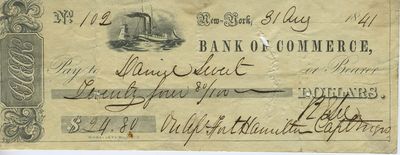
Robert E. Lee Signed Check
Robert E. Lee Fort Hamilton NY, August 31, 1841 Robert E. Lee Highly Unusual Bank Check Signed A bank check fully engrossed by Robert E. Lee (1807-1870), future Confederate General, and signed by him as "R E Lee" at lower right. Written at Fort Hamilton, New York on August 31, 1841. Check No. 102 was drawn on the Bank of Commerce in New York and made payable to one Daniel Severt in the amount of $24.80. The excellent partly engraved check bears a fine vignette of shipping vessels at upper left. Cut cancellation and two small spindle holes, not touching signature. Age-toned, and with mounting traces verso. Else very good. Narrow oblong 8vo. Accompanied by a German-language newspaper portrait of Lee; and three postcards, one depicting Lee as a young officer, one showing Lee on his famous white horse Traveler, and one depicting Washington and Lee University (Lexington, Virginia). Before he rose to the prominent position of Commander-in-Chief of the Confederate Army during the Civil War, Lee, a West Point graduate, had served in the U.S. Army Corps of Engineers. Lee was transferred to Fort Hamilton, located at the Narrows in New York Harbor, earlier in 1841 to supervise improvements in its fortifications. This item comes with a Certificate from John Reznikoff, a premier authenticator for both major 3rd party authentication services, PSA and JSA (James Spence Authentications), as well as numerous auction houses. WE PROVIDE IN-HOUSE SHIPPING WORLDWIDE!- $5,500
- $5,500
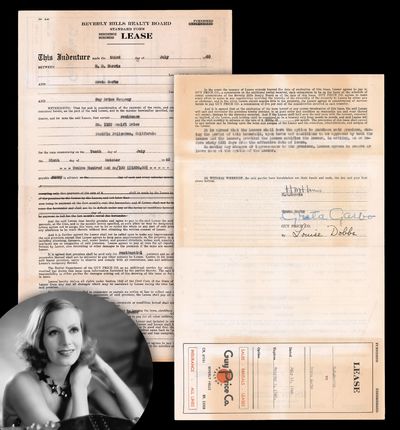
Greta Garbo Unusual Signed Early Document
Greta Garbo Greta Garbo Unusual Signed Early Document A document signed by Classic Hollywood actress Greta Garbo as "Greta Garbo". Dated July 3, 1940. One legal-sized page, both sides, 8.5" x 14". Four-month-long lease (July 10 - October 9, 1940) facilitated by Guy Price Realtors between Garbo and H.H. Harris for a residence in Pacific Palisades, California. The total cost of the rental was $1,200.00 payable in advance by Garbo. Also signed by Harris verso. Toning over signed panel and front of document, a small spot to the first name of signature and expected document wear, otherwise in fine condition. This item comes with a Certificate from John Reznikoff, a premier authenticator for both major 3rd party authentication services, PSA and JSA (James Spence Authentications), as well as numerous auction houses. WE PROVIDE IN-HOUSE SHIPPING WORLDWIDE!- $900
- $900
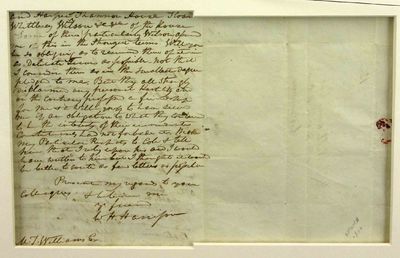
William H. Harrison ALS On Christmas, U.S. Senate Bid
William Henry Harrison North Bend Ohio, December 25 1821 William Henry Harrison ALS Requesting Friends Pull Strings to Ensure his U.S. Senate Bid 2pp autograph letter signed by future 9th U.S. President William Henry Harrison (1773-1841) as "W. H. Harrison" on the second page at bottom right. Written in North Bend, Ohio on December 25, 1821. The letter is on cream bifold paper. The first page and address leaf measure 12.25" x 7.875". The first and second pages have been inscribed by Harrison, while the third page is blank. The fourth page, consisting of a holographic integral address leaf, is docketed at top, bears a stamped philatelic marking from Cincinnati, and bears remnants of a red wax seal. Expected paper folds. Minor weathering to the address leaf and a few isolated holes found within the wax. Else near fine, with dark and bold handwriting. William Henry Harrison, the ex-military hero and aspiring Midwestern politician, wrote "MT Williams Esqr. / of the H of R of Ohio / Columbus". This was Micajah Terrell Williams (1792-1844), the Ohio politician. Harrison was writing to ask Williams--and many other mutual friends--to support his eventually unsuccessful bid for the U.S. Senate. Harrison's letter is direct in its persistent requests for Williams to rally Harrison's partisans. The entirety of this remarkable letter has been reproduced below, with unchanged spelling and punctuation: "North Bend 25th Dec 1821 Dear Williams I have written a sort of official notification to Captain Brown as the Senior of the Hamilton Delegation to communicate my wish to be considered as a candidate for the Senate of the U.S. "I rely with confidence on the support of all of you. Mr. Short will be prevented by our commission from taking an active part but the rest can + I am sure will. You + Genl Webb got so well acquainted with the members last year that you will have more in yr power than the others but the exertion of all will probably be necessary. There were a number of the upper members who last year voted against me solely from local considerations. Amongst those were Baldwin Mr Millan, Ogwatt Stone Jennings + Wheeler of the Senate and Harper Galt Lannon House Sloan Whittlesey Wilson +c+c of the House. "Some of these (particularly Wilson) assure me of this in the strongest terms. Will you be so obliging as to remind them of it in as Delicate Terms as possible - not that I consider them in the smallest degree pledged to me. But they all strongly disclaim any personal Hostility and on the contrary possess a friendship for me + a willingness to have (?) served me if an obligation to what they concern to be the interests of their immediate Constituents had not forbade it.Make my Particular Respects to Col. + tell him that I rely upon his aid I would have written to him but I thought it would be better to write as few letters as possible. "Present my regards to your colleague - + believe me yr friend W.H. Harrison M.T. Williams Esqr." William Henry Harrison had gained his first real political experience serving as governor of Indiana Territory between 1801-1812. In 1814, he had retired from the military and uneasily transitioned back to civilian life. Between October 1816-March 1819, Harrison served as an Ohio Congressman to the U.S. House of Representatives. Next followed two bitter political defeats: the first, Harrison's aborted bid for governor of Ohio in 1820; and the second, his loss of a U.S. congressional seat in 1822. Harrison did in fact reach the U.S. Senate, but it was not until March 1825. Harrison's correspondent M.T. Williams represented southwestern Ohio's Hamilton County (which included Cincinnati) in the Ohio House of Representatives. Williams was reelected in 1822-23 and served as the Speaker of the Ohio House of Representatives between 1824-1825. Later, Williams acted as a commissioner of the Ohio-Erie Canal. Harrison was elected to the U.S. Senate in 1824 as a Pro-Adams candidate, and served from 1825-1828, when President John Quincy Adams appointed him U.S. Minister to Colombia. He was elected President on the Whig ticket in 1840.He has the dubious distinction of the shortest presidency; Harrison died of pneumonia only a month after taking office. This item comes with a Certificate from John Reznikoff, a premier authenticator for both major 3rd party authentication services, PSA and JSA (James Spence Authentications), as well as numerous auction houses. WE PROVIDE IN-HOUSE SHIPPING WORLDWIDE!- $3,000
- $3,000
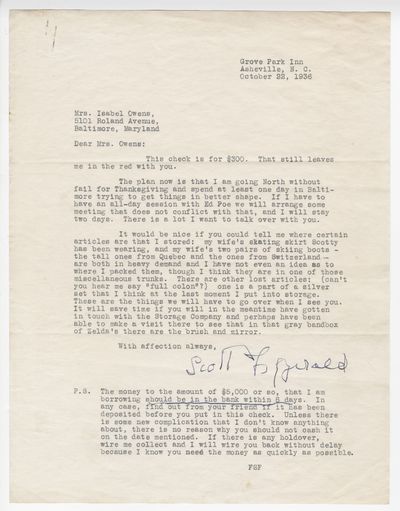
F. Scott Fitzgerald TLS About Zelda
F. Scott Fitzgerald Asheville NC, October 22 1936 F. Scott Fitzgerald, Perhaps the Last Loving Letter Re: Zelda, 1936 Single page typed letter signed, 8.5" x 11". Dated "Grove Park Inn, Asheville, N.C. /October 22, 1936". Signed by Fitzgerald as "Scott Fitzgerald", written to his secretary Isabel Owens. Near fine with a paper clip ghost and expected folds. The letter dated 1936, takes place in the midst of Fitzgerald moving his wife from the Phipps Clinic at Johns Hopkins in Baltimore to the Highland Hospital in Asheville. From the mid-1930s, Zelda spent the rest of her life in various stages of mental distress, but by 1936 she became violent and reclusive. Fitzgerald was both agitated and worried over his wife's illness noting that "Zelda now claims to be in direct contact with Christ, William the Conqueror, Mary Stuart, Apollo and all the stock paraphernalia of insane-asylum jokes... For what she has really suffered, there is never a sober night that I do not pay a stark tribute of an hour to in the darkness" In the letter offered here Fitzgerald prepares for Zelda's move to the new hospital facility. The importance of this letter cannot be understated as it may in fact be one of his last positive emotional bonds with his wife. He requests of his assistant "It would be nice if you could tell me where certain articles are that I stored: my wife's skating skirt Scotty has been wearing, and my wife's two pairs of skiing boots - the tall ones from Quebec and the ones from Switzerland - are both in heavy demand and I have not even an idea as to where I packed them, though I think they are in one of those miscellaneous trunks. There are other lost articles … It will save time if you will in the meantime have gotten in touch with the Storage company and perhaps have been able to make a visit there to see that in that gray bandbox of Zelda's there are the brush and mirror …" The treatment philosophy at Highland was different. Traditionally, in those days before psychotropic drugs, patients with chronic mental illness were shackled or put in straitjackets. Their idea was, "if you provided people with purposeful activities, good diet, exercise, fresh air and clean water ... that would be helpful for them" However Zelda remained in the hospital while Fitzgerald returned to Hollywood for a $1,000-a-week job with MGM in June 1937.Without Zelda's knowledge, he then began a serious affair with the movie columnist Sheilah Graham. Despite the excitement of the affair, he was bitter and burned out. When their daughter Scottie was thrown out of her boarding school in 1938, he blamed Zelda. Though Scottie was subsequently accepted by Vassar College, his resentment of Zelda was stronger than ever before. Of Fitzgerald's mindset, Milford wrote, "The vehemence of his rancor toward Zelda was clear. It was she who had ruined him; she who had made him exhaust his talents... He had been cheated of his dream by Zelda." After a drunken and violent fight with Graham in 1938, Scott returned to Asheville. A group from Zelda's hospital had planned to go to Cuba, but Zelda had missed the trip. The Fitzgeralds decided to go on their own. The trip was a disaster even by their standards: Fitzgerald was beaten up when he tried to stop a cockfight and returned to the United States so intoxicated and exhausted that he was hospitalized with the ever-growing resentment of Zelda, believing that she had cheated him of his dream. The Fitzgeralds never saw each other again. Financial matters for the Fitzgeralds took an unexpected turn for the worse, and for most of Fitzgerald's final years, finances weighed heavily on him. Fitzgerald, an alcoholic since college, became notorious during the 1920s for his extraordinarily heavy drinking, which would undermine his health by the late 1930s. Just one month prior to this letter, Fitzgerald's deteriorating mental state and drinking habits were captured publicly in an article published by Michel Mok titled "The Other Side of Paradise, Scott Fitzgerald, 40, Engulfed in Despair", first published in the New York Post, September 25, 1936. This is considered to have caused considerable damage to Fitzgerald's reputation and it is rumored that Fitzgerald tried to commit suicide after reading it. The letter offered in this lot also illustrates the state of his finances in his final years in which he discusses paying down a debt. His family had been hit hard by The Great Depression leaving him penniless. A phenomenal letter from a the tumultuous period of the remaining years of Fitzgerald's life. Especially revealing, as the letter was written during the transition of hospitals for his wife, and the gathering of her important personal attire. This perhaps represented one of the last times he would feel a loving bond with her. Fitzgerald wrote his last novel, Tender is the Night, in 1934 with another book of short stories published in 1935. Fitzgerald died in 1940 before he could complete The Last Tycoon. This item comes with a Certificate from John Reznikoff, a premier authenticator for both major 3rd party authentication services, PSA and JSA (James Spence Authentications), as well as numerous auction houses. WE PROVIDE IN-HOUSE SHIPPING WORLDWIDE!- $9,000
- $9,000
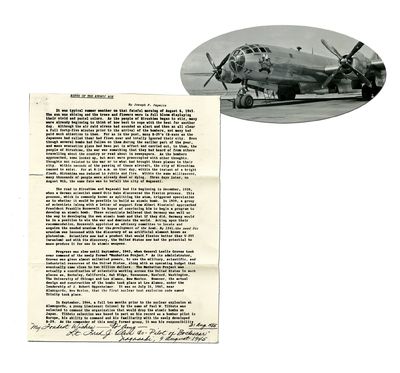
Atomic Bomb Bockscar Co-Pilot Olivi Signed Document
Atomic Bomb - Bockscar Bockscar Co-Pilot Olivi Autographs First Page of "Birth of the Atomic Age" FREDERICK J. OLIVI, Autograph Endorsement Signed, on copy of first page of Joseph F. Papalia, "Birth of the Atomic Age" typescript. "My Fondest Wishes – To Amy – 31 Aug. 1985 / Lt. Fred J. Olivi Co-Pilot of "Bockscar" / Nagasaki, 9 August 1945" 1 p., 8.5" x 11". Excellent. Frederick "Fred" J. Olivi (1922-2004) was the co-pilot of Bockscar, the plane that dropped the atomic bomb "Fat Man" on Nagasaki on August 9, 1945. Born in Chicago, Olivi enlisted in the Army Air Force immediately after the Japanese bombed Pearl Harbor in December 1941. After the war, Olivi served in the Air Force Reserve until 1971, when he ended his service as a lieutenant colonel. He worked for the City of Chicago until 1988, when he retired. Joseph F. Papalia (b. 1936) became the official historian of the 509th Composite Group in the 1980s. This item comes with a Certificate from John Reznikoff, a premier authenticator for both major 3rd party authentication services, PSA and JSA (James Spence Authentications), as well as numerous auction houses. WE PROVIDE IN-HOUSE SHIPPING WORLDWIDE.- $350
- $350
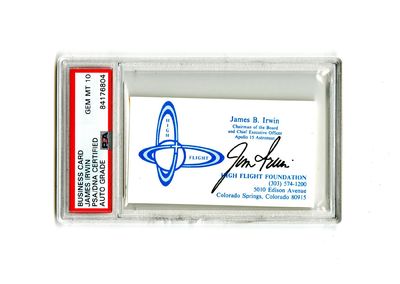
James Irwin, Astronaut, Signed Card
James Irwin James Irwin Signed High Flight Foundation Card, PSA Slabbed & Graded Gem MT 10! A business card signed by James B. Irwin (1930-1991), American astronaut and founder of the Hight Flight Foundation, as "Jim Irwin" recto. PSA slabbed and graded Gem MT 10. Slab measures 5.25" x 3.125". James Irwin served as Lunar Module Pilot during the Apollo XV mission (July 26-August 7, 1971.) Irwin was deeply affected by his experience on the moon, and it inspired his later evangelicalism. He resigned from NASA a year after Apollo XV, and in 1972, become the founding member and president of the High Flight Foundation headquartered in Colorado Springs, Colorado. The non-profit organization is still active today, and continues to provide emotional, spiritual, financial, and life skill support to military personnel. This item comes with a Certificate from John Reznikoff, a premier authenticator for both major 3rd party authentication services, PSA and JSA (James Spence Authentications), as well as numerous auction houses. WE PROVIDE IN-HOUSE SHIPPING WORLDWIDE!- $300
- $300
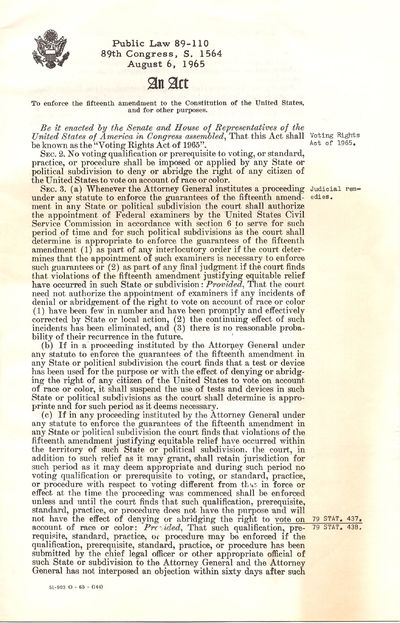
Rare Civil Rights 1965 Voting Archive
Civil Rights 1965 1965 Voting Rights Archive -- Rare A group of items related to to the Voting Rights Act of 1965, including two publications of the Act and an "Analysis of the Voting Rights Act of 1965." The first publication is 10pp, 6" x 9", entitled "Public Law 89-110, 89th Congress, S. 1564, August 6, 1965: An Act." The second publication, 19pp, 6" x 9", entitled "United States Commission on Civil Rights: The Voting Rights Act of 1965." Printed on salmon paper, the publication was a Commission of Civil Rights Special Publication, No. 4. This publication includes a printed copy of the Voting Rights Act of 1965, along with bulleted summaries of the act's coverage, enforcement, penalties, etc. These copies appear to have been mailed out to Americans following the passage of the act. Finally, there is a 35pp, 8" x 10.5", typed analysis of the Voting Rights Act of 1965, produced by the Washington Human Rights Project. Compiled by Richard Bosson, Reid Chambers, and Peter Johannsen. With an introduction by Director William Higgs. Minor uneven toning and soiling to all. Creasing to the lower corners of the printed analysis. This item comes with a Certificate from John Reznikoff, a premier authenticator for both major 3rd party authentication services, PSA and JSA (James Spence Authentications), as well as numerous auction houses. WE PROVIDE IN-HOUSE SHIPPING WORLDWIDE!- $1,500
- $1,500
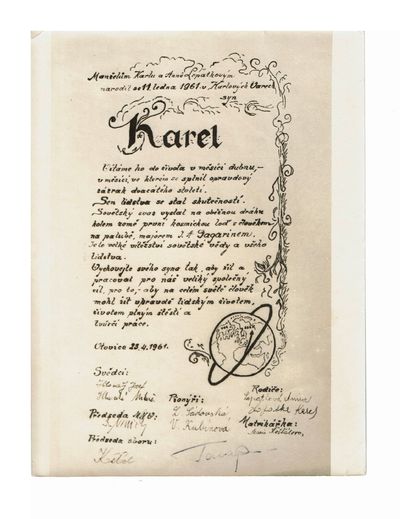
Gagarin Unusual Signed Large Certificate
Yuri Gagarin Czech Republic, April 23, 1961 Gagarin Unusual Signed Large Certificate GAGARIN, YURI. Printed Document Signed, 7" x 9.5", 1 p., Otrokovice, Czech Republic, April 23, 1961. Accompanied by a printed opinion, in Russian, that the signature is authentic and comes from the Cosmonaut's archive. A highly unusual autograph. Karel and Anna Lopatka asked Gagarin to sign their new baby's birth certificate while registering his birth around the time of Gagarin's flight. Apparently, it was a common practice for Czech parents to officially register the name of their baby several months after the actual date of the baby's birth. Abbreviated translation, in part, "To Karel and Anna Lopatka, whose son Karel was born in Karlovy Vary on June 11, 1961 / We welcome Karel to life in April, the month that had witnessed the true miracle of the century. Humanity's dreams became a reality - the Soviet Union had put into orbit the first manned spaceship with Major Yuri Gagarin on board." Yuri Gagarin (1934 - 1968) was a Soviet Air Force pilot and cosmonaut who became the first man to travel into outer space. His capsule, Vostok 1, completed one orbit of Earth on April 12, 1961. Gagarin became an international celebrity and was awarded many medals and titles, including Hero of the Soviet Union, his nation's highest honor. This item comes with a Certificate from John Reznikoff, a premier authenticator for both major 3rd party authentication services, PSA and JSA (James Spence Authentications), as well as numerous auction houses. WE PROVIDE IN-HOUSE SHIPPING WORLDWIDE.- $600
- $600

Clara Barton War Dated ALS About a Surgeon
Clara Barton Washington DC, January 8, 1865 Clara Barton War Dated ALS About a Surgeon, "a Native of Mississippi, a Natural Abolitionist" and a Member of Freedman's Bureau BARTON, CLARA. Autograph Letter Signed with docketing by Butler's office on verso. Two pages by Barton on card-style bifolium stationery measuring 5" x 8" folded. Folds and light chipping and discoloration to edges. Overall in very good plus condition, with bold, elegant writing. Beautifully penned letter by Clara Barton to General Benjamin Butler, her close friend and political ally. Barton writes on January 8, 1865 from Washington DC on behalf of her friend, Dr. R.O. Sidney, a close friend during the Civil War, who renounced his native Mississippi because he didn't believe in slavery. Barton writes in full, "Dear General / Permit me to introduce to you my old time friend of all the war, Surgeon R.O. Sidney, at present acting under direction of the Freedman's Bureau and stationed on the eastern shore of Va. Dr. Sidney is a native of Mississippi, a natural abolitionist, compelled to leave his home for proclaiming his sentiments some years previous to the war. He was a clerk in the Gen'l P.O. [Post Office] and a member of our family, when the rebellion broke out, and I have known him well during the intervening time. He has been intensely loyal, is naturally enthusiastic, generous, kind hearted & sympathetic, possessing great determination of purpose, and energy of character, and abounding in good practical sense and tact. Very naturally, he now wants to return to his old home, and reclaim the graves of his household, and desires an appointment from Genl Howard of such importance as will sustain him even among his former foes. I have never met General Howard (a circumstance which I daily regret) and in this dilemma I take the liberty to make this explanation to you General, and ask a kindly word from you, on Dr. Sidney's behalf, unless there should be some obstacle in the way which I may not understand. / Very respectfully / Yours / Clara Barton". This item comes with a Certificate from John Reznikoff, a premier authenticator for both major 3rd party authentication services, PSA and JSA (James Spence Authentications), as well as numerous auction houses. WE PROVIDE IN-HOUSE SHIPPING WORLDWIDE.- $2,500
- $2,500
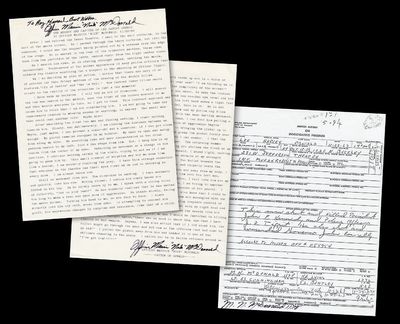
Lee Harvey Oswald Gripping Eyewitness Account of His Capture & Arrest
Lee Harvey Oswald Texas, 1963 L.H. Oswald Gripping Eyewitness Account of His Capture & Arrest Two documents relating to John F. Kennedy assassin Lee Harvey Oswald, compiled by Maurice "Nick" McDonald, the Dallas police officer who apprehended Oswald in the Texas Theatre. Comprised of a printed account 2x signed by Officer McDonald; along with a high-quality photocopy of an original Dallas Police Department record signed by Officer McDonald. 35th U.S. President John F. Kennedy (1917-1963) was shot by gunman Lee Harvey Oswald (1939-1963) in Dallas, Texas on November 22, 1963. Authorities reconstructed Oswald's whereabouts after the lunchtime shooting, tracing him from the 6th Floor of the Texas School Book Depository, to the Texas Theatre located in downtown Dallas. Oswald was discovered hiding in the movie theater by Officer Maurice "Nick" McDonald (1928-2005), who recounted the harrowing arrest in the account below. The lot provides us with eerie insights into the presidential assassin. The lot includes: 1. 2pp printed document entitled "The Arrest and Capture of Lee Harvey Oswald, by Officer Maurice 'Nick' McDonald, 11/22/63". Inscribed and signed by McDonald at the top of the first page as "To Roy Hansel [sic], Best Wishes, Officer Maurice 'Nick' McDonald". Also signed by McDonald at the conclusion as "Officer Maurice 'Nick' McDonald". A gentle corner fold and staple holes at upper left. Else near fine. 8.5" x 11". On the afternoon of November 22nd, Officer McDonald had reported to the Texas Theatre to investigate the shooting of fellow policeman J.D. Tippit, who was his friend and locker mate. Lee Harvey Oswald was the primary suspect. Officer McDonald wrote in part: "After I had entered the Texas Theatre, I went to the exit curtains, to the left of the movie screen… …I notice that there are only 10 or 15 patrons for this Friday matinee, of a showing of the double billed feature, 'Cry of Battle' and 'War is Hell'. How factual their titles would relate to reality in just a few moments!... Like a hunter, I am secretly stalking the prey [Oswald]…I am almost there now. Still no movement from him. The diversion is working. I turn suddenly and quickly, into his row. Moving closer, I notice his empty hands are folded in his lap. As he calmly looks up to me, I speak in a strong voice of authority, 'Get on your feet!' He has suddenly realized that he has waited too long to make a free and open move of aggression. He stands up slowly, facing the movie screen. Turning his head to me, we are face to face. I stare directly into his icy cold, steel blue eyes…" Officer McDonald was injured just moments later when Oswald attempted to fire point-blank range at him. 2. Photocopy of original Dallas Police Department record, Arrest Report on Investigative Prisoner Lee Harvey Oswald, showing McDonald as the primary arresting officer, and signed by McDonald as "M. N. McDonald 1178" along the bottom. In recognition of his heroism in capturing Oswald, McDonald received the Dallas Police Medal of Valor and was also inducted into the National Police Hall of Fame. McDonald retired from the Dallas Police Department as a sergeant, after 25 years on the force, in 1980. One can see from this excerpt that Officer McDonald had a natural talent for writing. He produced a longer manuscript, entitled "Oswald and I", in 1993. This item comes with a Certificate from John Reznikoff, a premier authenticator for both major 3rd party authentication services, PSA and JSA (James Spence Authentications), as well as numerous auction houses. WE PROVIDE IN-HOUSE SHIPPING WORLDWIDE!- $500
- $500
Charles Darwin ALS November 19, 1860: https://rarebookinsider.com/rare-books/charles-darwin-als-november-19-1860/